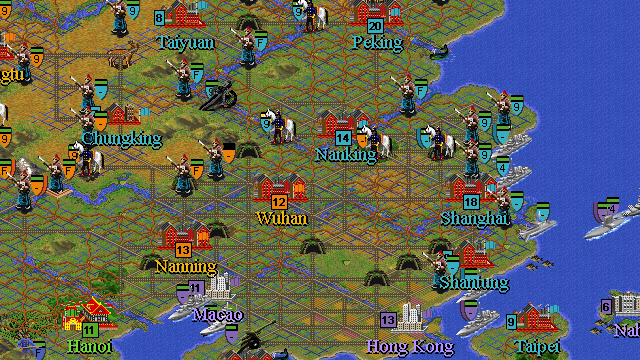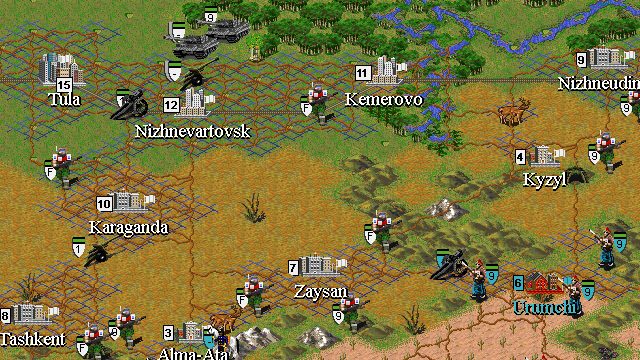History of Asia - Part B
Scenarios for Civilization II: Multiplayer Gold Edition by Patine.
Description
This set of five scenarios is a successor to the History of Asia - Part A set, and covers the history of East Asia and the Pacific between just after the First World War and a hypothetical Year 2010. It is important to note that certain key periods are excluded in this treatment that will, like the Mongol Horde and Feudal Japan periods in the "History of Asia, Part A" set, will be covered by other scenarios created by the author of this one, in time. These periods include the Korean and Vietnam Wars, which will be covered in greater detail than these scenarios allow, and the Early and Late Cold War periods, which I intend to cover globally. Each civilization has unique infantry and, in most cases, armor as well, and a few also have one or two other unique units. The statistics of these units vary by the actual military strengths and weaknesses of those nations in the real world. A few other new units also exist. I sincerely hope you enjoy this scenario, and the aforementioned scenarios covering the missing periods of the "History of Asia, Parts A and B" will be along as son as is humanly possible.
Fifth Scenario (1921-1941)
After the resolution of the First World War, Japan, having gained the Chinese city of Shantung (which had been leased to Germany previously) and the Marshall Islands in the peace settlement, began plans for a campaign of expansion across East Asia and the Pacific. This begins the stage for this scenario, and the back story to the Second World War in East Asia and the Pacific. You can play as the Japanese, coming under a militarist government and seeking to expand across the map (the Protagonist), or as the Thai, who, while technologically backward and geographically small, are growing closer to Japan diplomatically, or you can oppose Japan as the Soviets, a newly reorganized Communist state after several years of civil war (represented by their Siberian holdings and their puppet state in Mongolia), the French, with their colonies in French Indo-China, part of the Solomon Islands, and French Polynesia, the Chinese, who are pre-industrial and with a woefully corrupt and ineffective government, but with a big population and army, the Americans, with the Western U.S., as well as Alaska, Hawaii, Guam, the Philippines, and, due to strong influence, Northwestern Mexico, or the British Empire, with India (including Ceylon, Bangladesh, and Nepal), Burma, Malaysia, Singapore, Papua New Guinea, New Britain and New Ireland, Fiji, Australia, New Zealand, Micronesia, Samoa, Kiribati, Tuvalu, Hong Kong, and Western Canada, plus their close allies Portugal (with Macao and East Timor) and the Netherlands (with the Dutch East Indies). The goal is to, if Japan, to conquer as much as possible, and, if most others, to stop them. The scenario ends in %STRING2, just before the Pearl Harbor attack opens total war in the Pacific.
Sixth Scenario (1941-1947)
Tensions in East Asia and the Pacific have risen to all-out war. Japan has invaded China, conquering Manchuria and the Eastern third of the country, and now has turned their attentions to nearby European holdings, annexing Hong Kong, Macao, Northern and Central French Indo-China, Kiribati, and Tuvalu, beginning war with the British Empire and Free French. Thailand, hoping to annex much of the rest of French Indo-China, as well as Burma, has declared its full support for the Japanese. The Soviets remain safely behind a cease-fire with Japan, concentrating their efforts on the European Axis (off the map). The Americans have recently cut oil exports to Japan and frozen Japanese accounts in American banks to protest Japanese imperialism, which has led Japan to target the Hawaiian naval base at Pearl Harbor for a retaliatory strike...
Seventh Scenario (1948-1954)
The end of the Second World War has triggered new enmities as the democratic Western Powers clash with the Communist U.S.S.R. A clash over Korea between the two sides is imminent, though this war is not actually covered by this scenario (it's detailed in another scenario by the same author, and thus the Korean Peninsula and surrounding area are left off the map). This scenario actually covers the Cold War events in the surrounding area of East Asia and the Pacific. You can play as the Soviets, holding mostly Siberia and parts of the Asiatic republics, as well as their puppet state in Mongolia, and thus seek to spread your firm influence across the region, probably clashing with the West. The Vietminh, the Communist Vietnamese guerrillas who are fighting for Indo-Chinese liberation, hold Northern Vietnam and are blocked from expanding southward by the French Fortress Dien Bien Phu, save for some resistance in Central Vietnam. The beleaguered French still hold most of French Indo-China (though the Vietminh keep trying) as well as their Pacific holdings in the Solomon Islands and French Polynesia, and they're separate from the Western Powers player due to their current war. The Thai, meanwhile, have grown closer to the West with their failed association with Japan. China is divided between a Nationalist North and a Communist South, in irreconcilable conflict, as the Chinese Revolution heats up. The Western Powers, encompassing the Western United States (including Alaska, Hawaii, Guam, Samoa, Micronesia, the Marianas, and the Marshalls), the British Commonwealth (including Western Canada, Kiribati, Tuvalu, Fiji, part of the Solomon Islands, Papua New Guinea, Australia, New Zealand, Singapore, Malaysia, Burma, and Hong Kong), the Dutch East Indies (for the Netherlands), Macao and East Timor (for Portugal), American-occupied Japan, and, even though they became independent from their colonial rulers the year before the scenario starts (the former from the United States, the latter two from the British Empire), the Philippines, India, and the East Pakistan (now Bangladesh) to represent the strong initial influence their former colonial masters still command, as well as, due to strong affiliations with the West, Mexico and Nepal. The goal is to contain (if the French, Thai, Nationalist Chinese, or the Western Powers) or expand (if the Soviets, Vietminh, or Communist Chinese) the power of Communism in the world.
Eighth Scenario (1965-1979)
The Cold War between the Communist and Democratic nations has been in full swing for almost two decades. In Southeast Asia, the American "police action" in Vietnam futilely attempts to check the spread of Communism. That conflict, however, is detailed fully in another scenario by the author of this one that's coming soon. The conflict in this scenario covers the surrounding Cold War events in the rest of East Asia and the Pacific. You may play as the Soviets (controlling Siberia and the Asiatic Republics plus their puppet state of Mongolia) and attempt to dominate politics in the region to perpetrate the spread of Communism. You may try the Japanese, though they're not recommended as they're wealthy but not too powerful (though if left alone long enough, they could build a sizeable force). The North Koreans may seek to finish the Korean War goal and annex South Korea, despite the American presence there. The Commonwealth of Nations (controlling Western Canada, Australia, New Zealand, Papua New Guinea, New Ireland, New Britain, Kiribati, Tuvalu, Fiji, Hong Kong, Singapore, Bangladesh, and Sri Lanka, as well as their allies France {through the Solomon Islands and French Polynesia}, Portugal {through Macao} and Nepal) and the Americans (including the Western United States, Alaska, Hawaii, Guam, the Mariana and Marshall Islands, and American Samoa, and, through close ties and the Americans' protection, Northwestern Mexico, Taiwan, and South Korea) begin allied and generally opposed to the spread of Communism. The Chinese are Communist, though unfriendly to both the Soviets and the two Western players, and they seek consolidation. The Indians, though technically a Commonwealth country, are friendly (though not allied) to the Soviets. Also, the Philippines and Indonesia are both under volatile regimes (Indonesia's even left the United Nations) and thus are barbarian states.
Ninth Scenario (1990-2010)
The Cold War has ended with the dissolution of the Soviet Union, though conflict has not left East Asia and the Pacific. In this uncertain time, you may play one of seven factions. The Russians are under a more democratic but corrupt regime, still having on the map Siberia, but being bereft of their Asiatic republics, though still possessing a formidable nuclear arsenal. The Japanese are still an economically potent but militarily limited democracy, but have the industry to raise a sizeable armed forces in short order if need be. The North Koreans and Vietnam represent the last remnant of anti- American Communist states (besides Albania and Cuba, which are off the map), and seek retribution against U.S. interests. The Chinese are at peace with the West, and are stable trading partners, but may conflict with the U.S. over Taiwan. The Western Powers include Australia and New Zealand, Northwesternmost Canada, the American states of Alaska and Hawaii and their territories and affiliated states of Guam, American Samoa, and the Mariana and Marshall Islands, as well as their allies Portugal (represented by Macao) and France (represented by French Polynesia), and the U.S. protected states of Taiwan and South Korea. The Indians control India and are in a transitional period regarding diplomatic stance. And, finally, the Neutrals control all remaining countries on the map. China and India have become nuclear powers, and North Korea likely won't be far behind. Although the handover is not due until seven years into the scenario, China begins with Hong Kong due to the limits of the AI. The goal is to make the most of your situation in the scenario.
Screenshots
Downloads
Scenario Files (295 kB)
Sound Files (805 kB)

